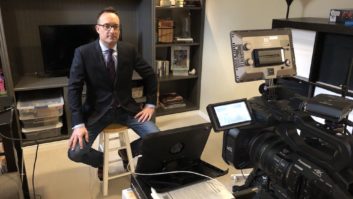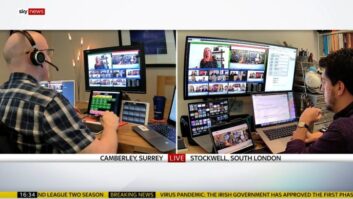The past year has seen broadcasters, OTT services and technology manufacturers taking serious decisions to continue trading during the Covid-19 crisis. Some have taken drastic action, while others took a longer view.
The economic viability of a company can be gauged by studying its quarterly or yearly figures. Using these in conjunction with projections based on market research and expert opinion, chief executives, managing directors and financial officers are able to make decisions about how best to keep the firm going through difficult times and, if it is a public organisation, satisfy the shareholders.
In reality, of course, business can be affected by many factors and variables. World events – political upheavals, natural disasters, trade wars, financial crises – can occur suddenly and unexpectedly, unsettling the markets and putting pressure on companies of all types. The coronavirus pandemic is the most extreme occurrence of such an unforeseen event in many years and has seriously affected businesses worldwide.
Some firms in many different sectors reacted cynically by taking the opportunity to close parts of their operations, cut staff and generally reduce investment. Others took advantage of government assistance – such as furlough schemes, where employees are given a leave of absence with a proportion of their wages paid by the state – or restructured to continue trading as normally as possible.
Individual companies will have their own reasons for reacting in a certain way but are job cuts and reducing budgets or investment in R&D the inevitable or sensible reaction to adverse economic conditions? “Not necessarily in the first instance,” comments Craig Bury, chief technology officer of UK consultancy and technology development company Three Media. “This is where deploying advanced automation and significant process and workflow improvements come in. Once those have been addressed, then, should trends continue, additional changes can be made without negatively impacting the company’s ability to meet its obligations and ensuring growth and new initiatives can be maintained.”
Bury observes that quarterly or yearly figures “inform the thinking but not necessarily trigger actions unless the trends are significant”. Three Media managing director Debra Slater, adds, “From what we have seen recently it appears the quarterly/yearly figures have escalated decisions to cut staff, mainly due to the impact of the pandemic. These cuts may have happened anyway but it’s probable they would have been phased and the resources targeted may have been more focused to align with a change in strategy. Such a reaction is not inevitable or sensible but it is understandable as an immediate reaction to poor results or changes in the economy.”
Amit Patel, founder and chief executive of digital business platform specialist Symbox, comments that figures and results can contribute to commercial decisions but says other indicators – client profile (such as the size of a customer), sector focus and ‘pain points’ are key in ensuring the right value and outcome is achieved. Ultimately, he says, “There needs to be a rebalance of costs,” he adds. “to ensure the right focus is applied to areas where risk is reduced but the opportunity to grow in challenging times is front and centre of the strategy.”
Different companies are run and financed in different ways but, says Andreas Hilmer, director of marketing at German console and IP system developer Lawo, financial and economic boundaries are the same for all. “Everyone is affected by external factors,” he explains. But, Hilmer acknowledges, the view can be different for a privately owned, family-run business like Lawo: “We are in the lucky position of not having to deliver so much on quarterly reports. But we can only spend what we get in and any decisions go back to a long-term perspective.”
For a company of Lawo’s structure and philosophy, knee-jerk reactions are not an option. “If quarterly figures are challenging, it doesn’t do to make short-term decisions, such as cutting staff or R&D,” Hilmer says. “Anything like that affects the future. But you can partially compensate if you don’t have to deliver [profits for] shareholders, you can act differently and react more on behalf of the customers while keeping your staff in place.”
Blackmagic Design (BMD) has built its reputation for bucking market trends and going against established business methods as much as for its innovative products. From starting out with a macOS capture card, the Australian company now has a product range that includes cameras, production switchers, film scanners and the DaVinci Resolve colour correction/editing/audio platform. “If you’ve got good products, the rest falls into place,” states BMD founder and chief executive Grant Petty. “The economy doesn’t drive everything.”
Petty comments that BMD has “done well” despite the problems caused by Covid-19. “It could have affected sales but people have built homes studios for remote working and large organisations have taken advantage of having fewer or no staff in their broadcast centres to rebuild and install new systems.” Petty says he has no time for what he calls “the slash and burn guys”, companies that take the opportunity to cut staff and budgets at the first sign of trouble. “You have to take care of people and surround yourself with smart people where possible,” he adds. “When we bought DaVinci it was haemorrhaging money but we fixed that.”
In similar vein, Lawo took what was seen at the time as the risky financial decision to invest in digital audio console development when it was not the trend it subsequently became. “You’ve got to allow business to build up,” says Andreas Hilmer. “In the current Covid situation it’s been better to furlough people than let talent go. And you’ve got to think about other parts of the industry. Cutting back on trade shows and media organisations can make the whole industry suffer.”
There is general agreement that the broadcast technology market is resilient but, as Three Media’s Debra Slater points out, Covid-19 has led to fundamental changes in viewing habits and, consequently, how programmes are distributed. “The pandemic has generated an accelerated growth in streaming and on-demand services,” she says. “This change in user behaviour has resulted in significant shifts in company strategy, with many top broadcasters moving towards a more fluid exploitation and monetisation approach across linear and digital platforms alike.”
Slater concludes that reductions in the wrong areas will stunt revenue generation in the longer term. Which is something broadcasters, OTT services and manufacturers would do well to bear in mind and not make drastic decisions.







